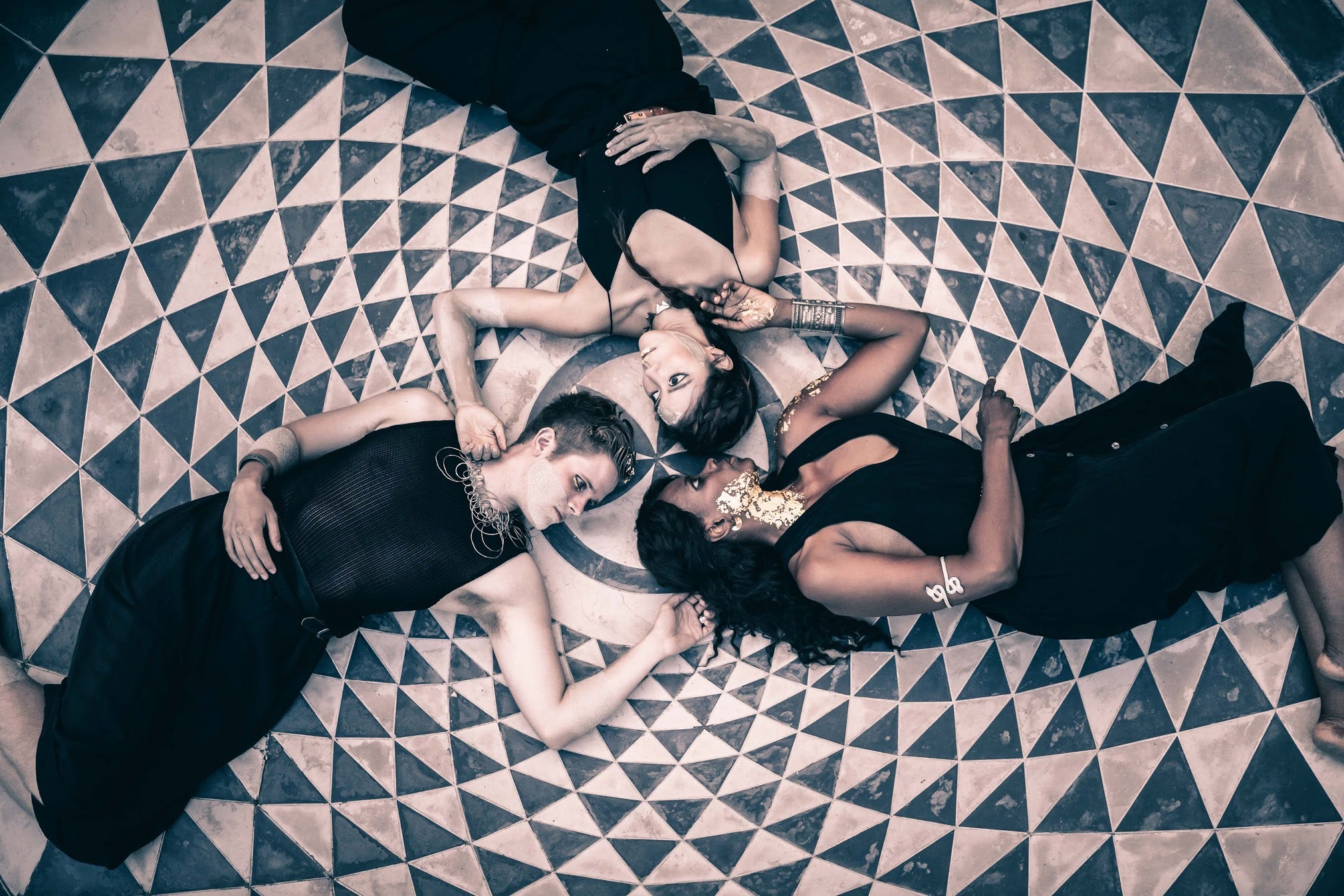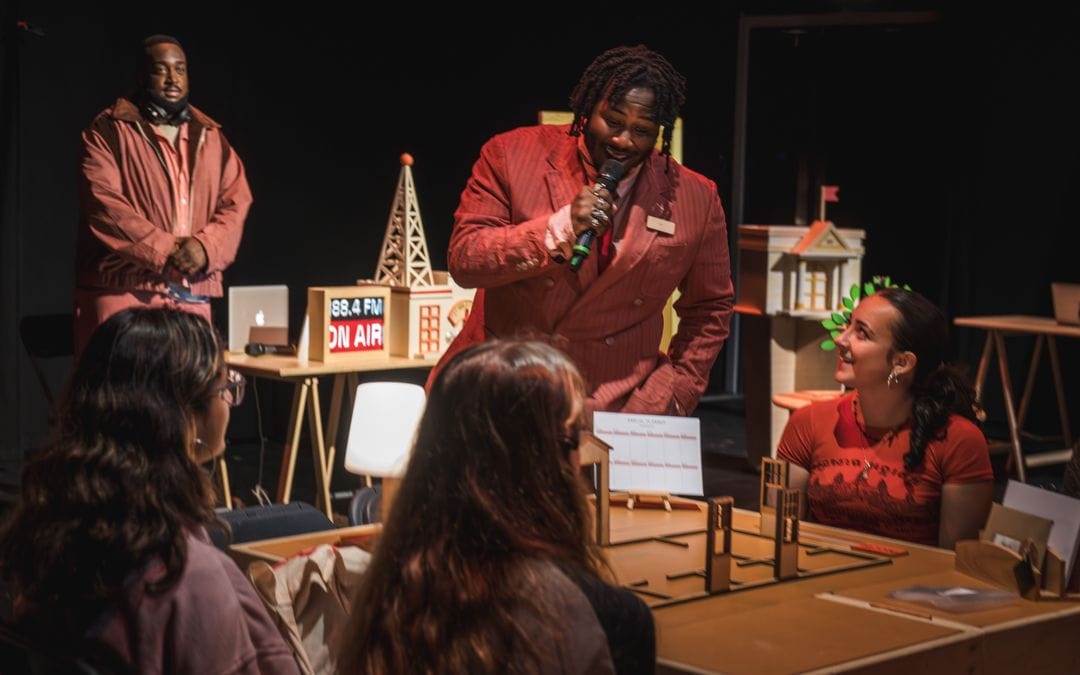
fourlarks’ Katabasis was supposed to run in early November. Then the devastating Woolsey Fire spread throughout Southern California and their performance site at the Getty Villa was shut down.
They quickly threw together a revised concert version of their show, but weren’t sure if their show would ever be performed as intended. As luck would have it though, the Getty Villa was able to offer them one weekend in January to remount the performance and fourlarks was able to get everyone back together.
And now people will have the chance to see Katabasis in its entirety.
We talked with Mat Sweeney of fourlarks via email to learn more about the show, staging it at the Getty Villa, and dealing with the cancellation (and subsequent remount).
This interview has been lightly edited for clarity.
No Proscenium: In a nutshell: what is Katabasis?
Mat Sweeney: Katabasis is a processional opera that winds around the grounds and gardens of the Getty Villa. The performance is styled after the rites of ancient mystery cults, in which a group of initiates would ceremonially enact a mythological episode. Katabasis means ‘a descent to the underworld’ (in this context) and describes the narrative journey of the piece. Our ensemble of 13 multi-disciplinary performers (they all play instruments, sing, move, channel deities, etc) guide the audience on the journey of the soul (or whatever) after death. The performance reflects the Getty Villa’s current exhibition Underworld: Imagining the Afterlife, but it is not by any means a historical reenactment. The musical and visual aesthetic and the philosophical questions posed are contemporary and reflective of our artistic community. In LA! In 2019!
In a smaller nutshell, it’s 13 incredible musicians singing songs for the dead in one of the most beautiful places in LA!
NP: Why are you interested in telling this story now?
MS: Death is certainly as relevant to us as it was to the ancients, right? Ominous, terrifying, fascinating, romantic, and central to the experience of being a human. I’d like to think the performance offers audience members an opportunity to reflect on their own mortality, and take an introspective pilgrimage to connect with something or someone they’ve lost. Katabasis’ call to action is to take advantage of the limited time we’re allotted, to let the looming spectre of death inspire creativity rather than fear, and to leave the earth a lil better than we found it. But it’s also a really nice walk around a beautiful space, alongside some extraordinary shape-shifting virtuosos — I’m happy for our guests to engage at whatever level suits their evening.
NP: How did you get involved with The Getty?
MS: The Getty Villa’s theatre lab program supports the development of new work by LA companies, which is pretty exceptional! Greco-Roman mythology is a recurrent source material for our work, so it’s been a great match! We’ve developed work at the Villa before, but this is our first time premiering a production together; we’re thrilled to be taking our relationship to the next level!
NP: And why the choice to perform this work there?
Get Kevin Gossett’s stories in your inbox
Join Medium for free to get updates from this writer.
SubscribeSubscribe
MS: Mystery rites like the one this performance emulates would very likely have been hosted in spaces that the Villa was designed to architecturally mimic. It’s a pretty magnificent layer of post-modern site-specificity that has been a huge creative driving force. We built the piece specifically for this space; the architecture is leading the narrative as much as the text and music.
NP: What was it like designing an experience for such a unique location? Getting access to The Getty Villa in this way is extremely cool!
MS: It’s a thrill! Working at the Villa is about as far as we can imagine from the industrial caves we typically haunt downtown (we are trying not to get too accustomed to the Getty lifestyle). Knowing how exceptional this opportunity is, we set out to take full advantage of all of the Villa’s architecture, gardens, fountains, corridors, etc. It may well be the most extraordinary palate we ever get to create with. It’s been a colossal effort on the part of the Getty to open all of these spaces for performance, and we’re deeply grateful for their trust in our creative vision!
NP: Did the piece come about because of the Imagining the Afterlife exhibition?
MS: Yes! The Villa typically programs work that somehow compliments their special exhibitions, but I think this is the first time a piece has ever been created directly in response to an exhibition (at the Villa). It’s been such a dream to have this rich well of source material (artifacts in the exhibition inform our text, narrative, design, choreography, etc…), and to have the exhibition’s brilliant curator David Saunders as a dramaturgical resource. Audiences are invited to visit the exhibition directly after the performance, which we think of as an essential part of the experience!
NP: The original run of this who had to be altered and canceled because of the fires in Southern California. What was that experience like?
MS: It was insane! Obviously our main concern was the deep devastation caused by the fires across the state, and the real-life effect it had on folks in our community. But it was kind of wild to face the prospect that we’d just created the most extravagant work of our lives and that it would never be seen or heard (which was the likely outcome communicated to us when the performance was canceled). There was definitely a lot to unpack about the ephemeral nature of life and how that is reflected in this piece and in live performance in general. My masochistic side sort of reveled in the idea of creating a piece that would only exist in the memories of its creators, an opera about death that could never live! But this crew is heroically unflappable, and rather than wallowing, we used the time lost to canceled shows to record an album of the music (available here) and present a concert version at our warehouse downtown. Since it seemed so unlikely that our site-specific piece would ever get to be experienced in its specified site, we really wanted to find an outlet for all the joy, blood, and sweat we’d expended in its creation.
NP: Did it have any affect on the current production?
MS: We were very extremely surprised when the Getty called us in mid-December and offered us this January weekend to reschedule the show. By some strange miracle of fate the whole ensemble was available to come back for these three shows! Since this piece was written specifically for each of these performers, to replace any one of them would have required some extensive revisions, which would have made this timeline impossible. It will essentially be the same show that we built in November, but as if we scheduled a two month break just before final dress.
NP: As you developed this work, what influences did you find yourself coming back to?
MS: The architecture of the Villa, the exhibition, and the performers themselves. They all have individual art and music making practices that are deeply inspiring to me, and the material I’ve written for them reflects my infinite fandom. I feel like my job is to put together an ensemble and set a template for them to do what they do. The deep admiration runs pretty thick amongst the whole crew, and hopefully that energy permeates the audience as well. Oh man, that language is pretty cult-y isn’t it?
NP: What experience do you have creating immersive experiences?
MS: fourlarks has been making site-responsive music-driven performance work since 2008. We’ve always been cautious about using ‘immersive’ as a descriptor, with reverence to our friends and colleagues who are making interactive work with participant agency. This piece, like many of our previous projects is roving, multi-dimensional, and enlists the audience to participate collectively, but there is a distinct proscenium present at all times (partly reflective of our institutional partner, but mostly of our desire for the audience to see and hear the movements of this piece from a particular vantage point). The form we’re working in shifts with every new project and reflects the contents of its source material. Here the audience is posited as a collective of initiates participating in a rite. As with most religious ceremonies there are chief enactors and a passive (but no less important) congregation of participants. Consequently we’ve been describing the performance as ‘processional,’ but not immersive.
NoPro is a labor of love made possible by our generous Patreon backers: join them today!
In addition to the No Proscenium web site, our podcast, and our newsletters, you can find NoPro on Twitter, Facebook, YouTube, Instagram, in the Facebook community Everything Immersive, and on our Slack forum.
Office facilities provided by Thymele Arts, in Los Angeles, CA.





















Discussion